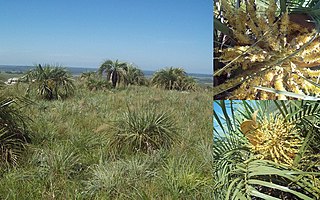Abatetia is a genus of flies in the family Dolichopodidae. It contains a single species, Abatetia robusta, and is found in New Zealand. The genus was originally known as Nelsonia, named by Octave Parent in 1933. The genus was then transferred to Cymatopus by Parent in 1937. Separately, David Miller found the name Nelsonia to be preoccupied by Nelsonia, and renamed it to Abatetia in 1945. However, the genus remained a synonym of Cymatopus until 1984, when it was restored as a separate genus by Henk J. G. Meuffels and Patrick Grootaert. Due to Nelsonia being preoccupied, Abatetia became the name of the genus.

Butia paraguayensis is a species of Butia palm tree found in the cerrado region of South America. Its natural range runs from Mato Grosso do Sul and São Paulo in southern Brazil through Paraguay to northern Argentina and Uruguay. It was given the name dwarf yatay palm in English by 2000, and it is locally known as yata'i in Guaraní in Paraguay, or butiá-do-cerrado in Portuguese in Rio Grande do Sul, Brazil.
Argentinia is a genus of flies in the family Dolichopodidae.
Ceratopos is a genus of flies in the family Dolichopodidae, known from Algeria and Portugal. It contains only one species, Ceratopos seguyi. It is closely related to Syntormon, and is considered a junior synonym of it according to Evenhuis & Bickel (2022).
Coeloglutus is a genus of flies in the family Dolichopodidae. It is known from Guatemala, Ecuador, El Salvador, the Lesser Antilles, Puerto Rico, Costa Rica, Venezuela, Bolivia, Panama and Peru, and contains only one species, Coeloglutus concavus.
Neotonnoiria is a genus of flies in the family Dolichopodidae. It is known from Brazil, Panama, Costa Rica and Peru, and contains only one species, Neotonnoiria maculipennis. The genus was originally named Tonnoiria by Octave Parent in 1929; however, this was preoccupied by TonnoiriaMalloch, 1929, so it was renamed to Neotonnoiria by Harold E. Robinson (1970).
Notobothrus is a genus of flies in the family Dolichopodidae. It contains only one species, Notobothrus longilamellatus, which is known from the lowland Amazonian Peru and northwestern Brazilian Acre State. It was formerly placed in the subfamily Neurigoninae, but was moved to Peloropeodinae by Naglis in 2002. In 2020, the genus was excluded from the Peloropeodinae and provisionally left incertae sedis within Dolichopodidae.
Physopyga is a genus of flies in the family Dolichopodidae found in mangroves in Papua New Guinea. It contains a single species, Physopyga miranda.
Scepastopyga is a genus of flies in the family Dolichopodidae. There is only one described species, Scepastopyga semiflava, which was described from Papua New Guinea by Patrick Grootaert and Henk J. G. Meuffels in 1997. An unidentified species of Scepastopyga was reported from Singapore in 2002, which is thought to show that the genus may be distributed across the Malesian Archipegalo. The fly is small, with a body length of about 2 mm, and is coloured yellow or brown without a metallic gloss.
Urodolichus is a genus of fly in the family Dolichopodidae. It is known from the Afrotropical realm, Indomalayan realm and Australasian realm. It has been placed in either Rhaphiinae or Diaphorinae, though Grichanov & Brooks (2017) consider the genus to be incertae sedis within the family Dolichopodidae.

Hydrophorinae is a subfamily of flies in the family Dolichopodidae. Several molecular phylogenetic analyses of the family have found evidence that the subfamily in its current sense is polyphyletic.

Achalcinae is a subfamily of flies in the family Dolichopodidae. It is an ancestral group close to Medeterinae and Sciapodinae.

Neurigoninae is a subfamily of flies in the family Dolichopodidae.

Sympycninae is a subfamily of flies in the family Dolichopodidae. In some classifications, this subfamily includes the genera of the subfamilies Peloropeodinae and Xanthochlorinae.

Rhaphiinae is a subfamily of flies in the family Dolichopodidae.
Bickelomyia is a genus of flies in the family Dolichopodidae. It is known from Mexico and Costa Rica. The genus is named after the Australian dipterologist Daniel J. Bickel.
Paracoeloglutus is a genus of flies from Chile in the family Dolichopodidae. It contains only one species, Paracoeloglutus chilensis. The generic name is a combination of the Greek word 'para' and Coeloglutus, a closely related genus. The specific name is derived from Chile, the country where P. chilensis was collected.
Dactylomyia is a genus of flies in the family Dolichopodidae.
Macrodactylomyia is a genus of flies in the family Dolichopodidae. It is known from Brazil, and contains only one species, Macrodactylomyia magnicauda. The generic name is a combination of the Greek word 'macros' and Dactylomyia. The specific name is a combination of the Latin words 'magnus' and 'cauda'.





